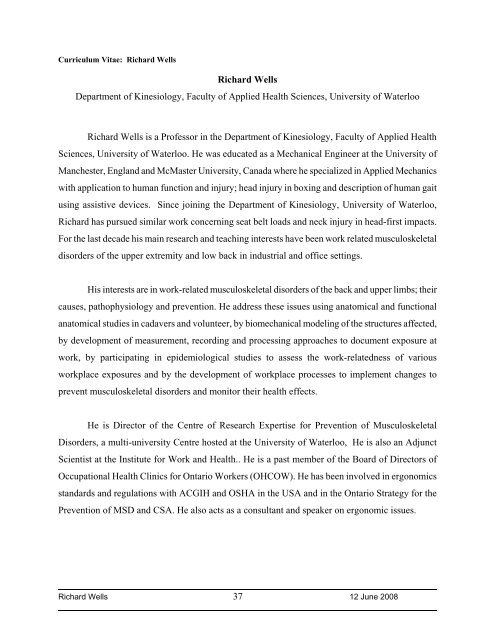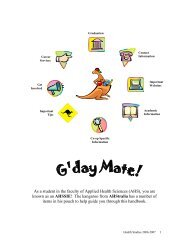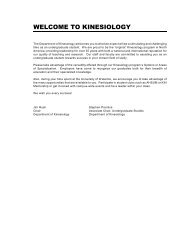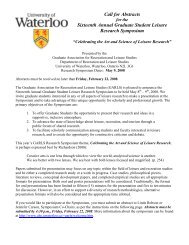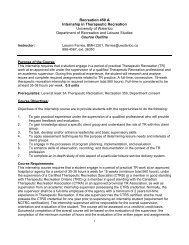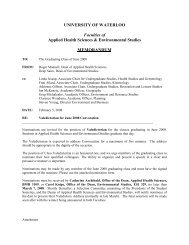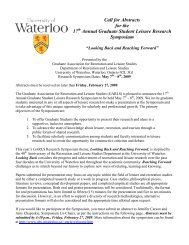Curriculum Vitae - Applied Health Sciences - University of Waterloo
Curriculum Vitae - Applied Health Sciences - University of Waterloo
Curriculum Vitae - Applied Health Sciences - University of Waterloo
Create successful ePaper yourself
Turn your PDF publications into a flip-book with our unique Google optimized e-Paper software.
<strong>Curriculum</strong> <strong>Vitae</strong>: Richard WellsRichard WellsDepartment <strong>of</strong> Kinesiology, Faculty <strong>of</strong> <strong>Applied</strong> <strong>Health</strong> <strong>Sciences</strong>, <strong>University</strong> <strong>of</strong> <strong>Waterloo</strong>Richard Wells is a Pr<strong>of</strong>essor in the Department <strong>of</strong> Kinesiology, Faculty <strong>of</strong> <strong>Applied</strong> <strong>Health</strong><strong>Sciences</strong>, <strong>University</strong> <strong>of</strong> <strong>Waterloo</strong>. He was educated as a Mechanical Engineer at the <strong>University</strong> <strong>of</strong>Manchester, England and McMaster <strong>University</strong>, Canada where he specialized in <strong>Applied</strong> Mechanicswith application to human function and injury; head injury in boxing and description <strong>of</strong> human gaitusing assistive devices. Since joining the Department <strong>of</strong> Kinesiology, <strong>University</strong> <strong>of</strong> <strong>Waterloo</strong>,Richard has pursued similar work concerning seat belt loads and neck injury in head-first impacts.For the last decade his main research and teaching interests have been work related musculoskeletaldisorders <strong>of</strong> the upper extremity and low back in industrial and <strong>of</strong>fice settings.His interests are in work-related musculoskeletal disorders <strong>of</strong> the back and upper limbs; theircauses, pathophysiology and prevention. He address these issues using anatomical and functionalanatomical studies in cadavers and volunteer, by biomechanical modeling <strong>of</strong> the structures affected,by development <strong>of</strong> measurement, recording and processing approaches to document exposure atwork, by participating in epidemiological studies to assess the work-relatedness <strong>of</strong> variousworkplace exposures and by the development <strong>of</strong> workplace processes to implement changes toprevent musculoskeletal disorders and monitor their health effects.He is Director <strong>of</strong> the Centre <strong>of</strong> Research Expertise for Prevention <strong>of</strong> MusculoskeletalDisorders, a multi-university Centre hosted at the <strong>University</strong> <strong>of</strong> <strong>Waterloo</strong>, He is also an AdjunctScientist at the Institute for Work and <strong>Health</strong>.. He is a past member <strong>of</strong> the Board <strong>of</strong> Directors <strong>of</strong>Occupational <strong>Health</strong> Clinics for Ontario Workers (OHCOW). He has been involved in ergonomicsstandards and regulations with ACGIH and OSHA in the USA and in the Ontario Strategy for thePrevention <strong>of</strong> MSD and CSA. He also acts as a consultant and speaker on ergonomic issues.Richard Wells 37 12 June 2008


